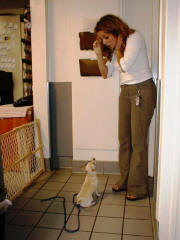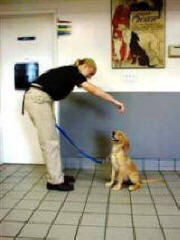|
Become a Pet-Centered Practice
Kinder, Gentler, Veterinary Visits for Pets
|
Why choose an "exam visit" instead of a "vaccine
clinic" visit?
A vaccine clinic visit
does not typically include a veterinary exam and
time to ask the veterinarian questions about
vaccines, parasite control, diet, behavior, how to
prevent illness and how to keep your pet in optimal
health. Because pets cannot tell you if they are in
discomfort, it is important they are thoroughly
examined once or twice a year by a veterinarian.
What can pet owners do to reduce the stress of a
veterinary visit?
Some pets are somewhat fearful by
nature or become stressed by veterinary visits. The
most common symptoms are hiding, trembling,
vocalization, or aggression. To ease any negative
emotional effects of nail trims or other minor
procedures that may not be very painful but seem
very stressful to this individual pet, the pet owner
can request mild sedation for an additional fee. One
goal of mild sedation or tranquilization is so that
the pet only remembers positive experiences at the
veterinary practice.
Take these steps for EVERY dog
and cat visit to the veterinary practice.
1. Withhold
food for
12 - 24 hours prior to the veterinary visit. Put
together a bag of special treats (small pieces of
meat, cheese, or any other tasty item NOT given at
home).

2. Give the first treat when getting in the
car to go to the veterinary practice, the second in
the parking lot of the practice, third as your go in
the door, fourth in the lobby, fifth on the scale or
exam table. Ask the veterinary staff to give your
pet treats. Act jolly and relaxed. Your pet reads
your body language and takes cues from your
emotions.
3. When the
veterinarian enters the room, ask he or she to give
your pet a treat. For puppies and dogs, it is even
better if the veterinarian and staff ask your pet to
sit, and then offer the treat. If your pet is
trained, use any waiting time to practice commands.
Make this a fun, interactive time for your pet.
4. Use treats to
distract the pet from injections and minor
procedures. Again, act relaxed. Your pet may interpret
soothing as confirmation of fear. Petting and
soothing a fearful pet often reinforces the fearful
behavior. Bring a string to chase or make a cheese
whiz line on the exam table to help distract your
cat. Or, make a cat burrito using a fluffy towel
from home with your scent on it.
5. Bring cats in
portable kennels or pillow cases. Cats like a place to hide. If your
cat will need to stay for a procedure, bring a
brown grocery bag and request that the bag be put in
the kennel BEFORE the cat. Being able to hide lowers
the cat's stress immediately.
6. For dogs that
tend to bark, distract with treats and prevent eye
contact with other pets. If you can, walk the
dog briskly outside securely on leash, offering
treats for frequent sits to release some of the
energy or tension.



With a
little extra effort, you can provide your pet with a
kinder, gentler veterinary and home experience.
Help
your pet to see the veterinary practice as the
"cookie place" not a "chamber of horrors".
See pets drag people in - not out - your door!